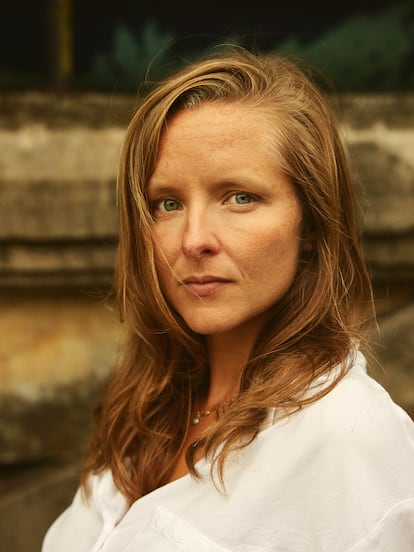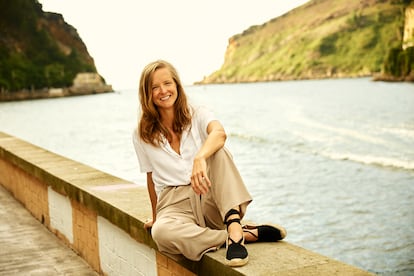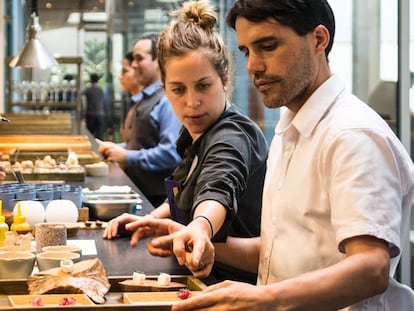Marti Buckley, gastronomer: ‘One of my missions in life is to defend Spanish cuisine against Italian and French cuisines in the US’
The journalist and cook from Alabama, based in San Sebastian, succeeded with a book on Basque gastronomy and has become an advocate of the Spanish culinary culture in the United States

Just five years ago, Marti Buckley published Basque Country: A Culinary Journey Through a Food Lover’s Paradise. The book, which was a success, was later translated into Spanish, and the Basque Academy of Gastronomy declared it the best book of 2019. Almost a decade had passed since this Alabamian fell in love with Spain’s Basque Country, its people and its food. Today she is a renowned journalist and cook who contributes in publications like Travel & Leisure and Wallpaper City Guides. When she is in San Sebastian, where she lives with her two daughters, she teaches Southern American cooking classes; when she is in the United States, she teaches Basque cuisine. She also works in marketing, used to have an ice cream sandwich cart in San Sebastian, was a pastry chef at the renowned The Loaf and leads the International Society for the Preservation and Enjoyment of Vermouth. She is currently finishing a new book about Basque pintxos.
Question: What struck you the most when you first arrived in the Basque Country?
Answer: I was 20 years old and there was a lot that I didn’t get, but the culture, the people, the language, the food bars struck me. Back then you could have a foie gras pintxo for €3. It was heaven. I found everything very different and interesting. And the sun, it’s always sunny when you come to visit, it’s very well thought out [laughs]. I read all the available books in English about the region, which were more or less four. I became a fan of all things Spanish; I drank Spanish wine, watched Almodóvar movies – all this at home in Alabama. I was obsessed, I was hooked. I don’t know, maybe if I had gone to Italy the same thing would have happened there.
Q. When did you become interested in gastronomy?
A. When I was 14 I used to make things like Oreo cakes or a Mexican-style cheese spread, but with canned ingredients. I had no idea of the possibilities. In Spain I understood that you can cook from scratch, that you can devote time to eating, that cooking is enjoyable.
Q. When and how did you decide to stay?
A. First, the idea was to stay for a year. Then… another year. I wanted to make that book of Basque recipes. The first year I realized that I was not ready yet, because I liked it a lot, but I was clueless. After three years, I found myself capable of thinking seriously about the book. All this made me stay here. Little by little, things became permanent.
Q. What did you think your book could contribute?
A. I wanted to tell the story of the traditional recipes. The most logical thing from a commercial point of view would have been to make a book about pintxos (which is exactly what I’m going to publish now). But I wanted to tell the whole context, from the history to the celebrations and details about the producers. I wanted to narrate the Basque culture through its food.
Q. What was your biggest challenge? Making Basque gastronomic culture interesting and understandable to an American reader, or narrating it without it seeming amateurish to the locals?
A. Well, it was published in English by an American publisher, but always thinking about the Basque grandma who was going to read it looking for a mistake. I couldn’t change anything. I had to tell everything really well. It was translated into Spanish two years later. Everything has gone very slowly; I spent years researching before the book, appearing on Basque TV, on the radio. So when the book was published I was already settled. I feel good because I am aware of the work I’ve done, the research that’s behind it, and I feel confident answering any questions. I am in love with this land and its cuisine. I’m not here to make money fast… well, nor slow [laughs]. I want to be a good ambassador and I take it very seriously.
Q. So what did the grandmas say?
A. The year after it came out, they gave me the prize for the best publication at the Basque Academy of Gastronomy, and that was more exciting than the success in the US. A friend actually gave the Spanish version to her grandmother, and she took out a pen, ready to correct everything that was wrong, but she couldn’t find anything to correct.

Q. How was your experience in a bakery?
A. I was the dessert girl at The Loaf. Three of my friends set it up. I know a lot about pastries, ice cream, my idea was to show what good confectionery is to the people here. They gave me complete freedom. I like rustic things more than fine ones. The puff pastry here doesn’t convince me. People here are too afraid of getting fat and don’t use enough butter and sugar; we use much more and it comes out tastier.
Q. Why didn’t you continue with your ice cream sandwich project?
A. It was a super arduous project. Making the cookie dough, the ice cream... I made them and sold them, all day on the street. It was fun and exhausting. And all kinds of things happened to me. One day an American man came and invited me to have lunch with him at [the world-famous restaurant] Mugaritz; after the meal he had a plane to catch. He didn’t want to see what happened next. He just didn’t want to eat alone, and he liked my ice cream.
Q. Are Americans more aware of the European reality now, or is it still a whole for many?
A. In 2010 nobody knew anything about this. Now it sounds more familiar to them, but I think that many are still not aware of where they’re going when they visit Europe. And when they arrive, they are amazed. After living your whole life with such a strict eating code, you come here and see wine, bars and people walking around the city all the time. One of the biggest tourist attractions is drinking, so everyone is happy. It is very easy to fall in love with this. The bad thing about living here is that you will never be on vacation in the city. I see the tourists and I envy them. I think that most Americans already know that Spain is not Mexico, and that’s something. More people come, they are better informed and want to be better tourists.

Q. How important is it to maintain a connection to one’s origins?
A. At first you want to shake it off in order to fit in, but the more I fit in here, the more I am interested in my American identity. But there was a time when I wanted nothing to do with the US. Now I am happy to buy my American ground coffee and do it the American way. Then there are issues like politics. After 2016 and Trump’s election, it was all very hard. Everything that happened, seeing it from afar, what happened on January 6, 2021 at the Capitol… it is becoming evident that our idea as a country has some flaws.
Q. How political is gastronomy?
A. There’s always someone who sees politics in everything. It’s true that gastronomy has a sociopolitical element. It deals with matters of poverty, of economic and power struggle, of cultural exchange, of oppressed people who have cooked and served other people. Now we are realizing that. I remember an interview I did for an American media outlet about the first book. At the end, the guy told me: ‘Well, I don’t know how we can talk about your book. You are an American in the Basque Country.’ And I replied: ‘The Spanish have conquered the world, they can defend themselves. I am not doing cultural appropriation.’ Now it’s looks bad if a white cook does something Mexican, for example. Whatever, the Basques don’t need an American man to defend them.
Q. Do you understand gastronomic patriotism?
A. I love it and I support it. One of my missions in life is to defend Spanish cuisine against Italian and French cuisines in the US. It doesn’t have that many followers there, and I must defend it [laughs]. There has not been enough promotion. There is no list of 20 Spanish dishes that the people there can name without thinking. Seriously, I want to try to help promote the cuisine from here, but I am a single mother living in the most expensive city in Spain... but still, I keep at it. If you saw the documents I have on my computer, with those ideas alone I would have 50 years of work.
Q. Your favorite part of starting a business are the ideas, isn’t it?
A. [Laughs] I think so... I could have opened an ice cream parlor, a restaurant, but I never did because I don’t handle the logistical part of the brain. I am more a person of ideas, of doing things – but easy things. I feel very good as a writer. An idea is born, you take it to its conclusion, you apply your creativity and you get a well-packaged project.
Q. What is your relationship with Instagram?
A. It’s already part of my being. Sometimes I delete it from my phone. I post something and if I don’t have anything planned for the next 48 hours, I delete the app. It’s a good way to do it, because after a few days you open it and there’s a lot in there [laughs].
Q. San Sebastian is now packed with tourists; do you feel partly responsible for the overcrowding?
A. No! Well, I do think about it sometimes… Although I know I’ve made a lot of decisions not to make it worse. It could have done a lot more damage [laughs]. I haven’t caused more damage than necessary. And always trying to talk about places in this country within a context. Never going for what’s easy. It’s something I always think about. I got the offer to make a guide and I said no, because I don’t want to make junk food.
Q. Could you fall in love with someone with no taste?
A. If they were open to learn...
Q. After 25, no one learns anything anymore.
A. They do, I taught both of my daughters’ fathers... of course, it is true that there is almost no one who hates oysters and at the same time is a cultured and interesting person.
Sign up for our weekly newsletter to get more English-language news coverage from EL PAÍS USA Edition
Tu suscripción se está usando en otro dispositivo
¿Quieres añadir otro usuario a tu suscripción?
Si continúas leyendo en este dispositivo, no se podrá leer en el otro.
FlechaTu suscripción se está usando en otro dispositivo y solo puedes acceder a EL PAÍS desde un dispositivo a la vez.
Si quieres compartir tu cuenta, cambia tu suscripción a la modalidad Premium, así podrás añadir otro usuario. Cada uno accederá con su propia cuenta de email, lo que os permitirá personalizar vuestra experiencia en EL PAÍS.
¿Tienes una suscripción de empresa? Accede aquí para contratar más cuentas.
En el caso de no saber quién está usando tu cuenta, te recomendamos cambiar tu contraseña aquí.
Si decides continuar compartiendo tu cuenta, este mensaje se mostrará en tu dispositivo y en el de la otra persona que está usando tu cuenta de forma indefinida, afectando a tu experiencia de lectura. Puedes consultar aquí los términos y condiciones de la suscripción digital.
More information
Archived In
Últimas noticias
Most viewed
- Sinaloa Cartel war is taking its toll on Los Chapitos
- Oona Chaplin: ‘I told James Cameron that I was living in a treehouse and starting a permaculture project with a friend’
- Reinhard Genzel, Nobel laureate in physics: ‘One-minute videos will never give you the truth’
- Why the price of coffee has skyrocketed: from Brazilian plantations to specialty coffee houses
- Silver prices are going crazy: This is what’s fueling the rally










































